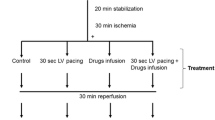Summary
The effects of infusing superoxide dismutase (SOD) and catalase (CAT) into the coronary circulation were investigated in isolated, working rat hearts prior to and during a 15 minute episode of regional ischemia followed by 30 minutes reperfusion. Aortic output, left ventricular pressure and dP/dT were recorded. Compared to untreated hearts, SOD and CAT significantly improved function during reperfusion, but had no effect during the pre-ischemic or the ischemic period. To investigate possible transport of SOD and CAT into rat myocytes, cryotome sections of isolated, Langendorff perfused rat hearts were exposed to rabbit antibody prepared against the exogenous SOD and CAT. Bound antibody was detected by the indirect-fluorescent antibody test. The interior of myocytes from rat hearts exposed to SOD and CAT bound antibodies prepared against these enzymes, whereas myocytes from rat hearts not exposed to exogenous SOD and CAT only bound the CAT antibodies. This indicates the anti-SOD we prepared is specific for exogenous SOD, and also suggests exogenous SOD can gain access to the cytoplasm of myocytes from the coronary circulation.
Similar content being viewed by others
References
Burton KP: Superoxide dismutase enhances recovery following myocardial ischemia. Am J Physiol 248: H637–H643, 1985
Zweier JL, Flaherty JT, Weifeldt ML: Direct measurement of free radical generation following reperfusion of ischemic myocardium. J Mol Cell Cardiol 18 (Supplement 3): 79, 1986
Zweier JL: Measurement of Superoxide-derived free radicals in the reperfused heart. J Biol Chem 263: 1353–57, 1988
Roy RS, McCord JM: Superoxide and ischemia: Conversion of xanthine dehydrogenase to xanthine oxidase, oxyradicals and their scavenger systems: In: R Greenwald, G Cohen (eds). Cellular and Medical Aspects, Vol 2: Elsevier/N. Holland Biomedical Press: New York: pp 145–53, 1983
McCord JM: Ischemia and free radicals. Federation Proceedings 46 (4): 1987
Podzuweit T, Brauwn W, Muller A, Schaper W: Xanthine oxidase derived free radicals are not involved in genesis of arrhythmias and infarction in the ischemic pig heart. Federation Proceedings 46 (4): 5774, 1987
Vaughan DM, Koke JR, Bittar N: Ultrastructural peroxisomes and lipid peroxidation in reperfusion myocardium. Cytobios 55: 71–80, 1988
Edoute Y, Van der Merwe E, Sanan D, Kotze JCN, Steinmann C, Lochner A: Normothermic ischemic cardiac arrest of the isolated working rat heart: Effects of time and reperfusion on myocardial ultrastructure, mitochondrial oxidative function, and mechanical recovery. Circ Res 53 (5): 663–678, 1983
Jennings RB, Ganote CE, Reimer DA: Ischemic tissue injury. Am J Pathol 81: 179–198, 1975
Okabe E, Hess ML, Oyama M, Ito H: Characterization of free radical-mediated damage of canine cardiac sarcoplasmic reticulum. Arch Biochem Biophys 225: 164–177, 1983
Manson NH, Hess ML: Interaction of oxygen free radicals and cardiac sarcoplasmic reticulum: Proposed role in the pathogenesis of endotoxin shock. Circ Shock 10: 205–213, 1983
Hammond B, Hess M: The oxygen free radical system: Potential mediator of myocardial injury. J Am Coll Cardiol 6:215–220, 1985
Chien KR, Reeves JP, Buja LM, Bonte F, Parkey RW, Willerson JT: Phospholipid alterations in canine ischemic myocardium. Circ Res 48: 711–719, 1981
Das DK, Engelman RM, Rousou JA, Breyer RH, Otani H, Lemeshow S: Role of membrane phospholipids in myocardial injury induced by ischemia and reperfusion. Am J Physiol 251: H71–H79, 1986
Noronha-Dutra AA, Steen E: Lipid peroxidation as a mechanism of injury in cardiac myocytes. Lab Invest 47 (4): 346–353, 1982
Sirna SJ, Schroeder E, Kieso R, Kerber R: Occult myocardial stunning occurs after 5 minutes coronary occlusion and is prevented by superoxide dismutase and catalase. Federation Proceedings 46 (4): 1897, 1987
Przyklenk K, Kloner RA: Superoxide dismutase plus catalase improve function in the canine model of the ‘stunned myocardium’. Circ Res 58: 148–156, 1986
Bulkley GB: Role of endothelial cells in free radical-mediated reperfusion injury. FASEB J 2 (5): A1267, 1988
Werns SW: Oxygen free radicals and white blood cells. Federation Proceedings 46 (4): 1897, 1987
Mullane KM: Leukocytes free radicals and postischemic cardiac dysfunction. FASEB J 2 (5): A1267, 1988
Neely JR, Liebermeister H, Battersby EJ, Morgan HE: Effects of pressure development on oxygen consumption by isolated rat heart. Am J Physiol 212: 804–814, 1967
Selye H, Bajusz E, Grasso S, Mendel P: Simple techniques for the surgical occlusion of coronary vessels in the rat. Angiology 11: 398–407, 1960
Hearse DJ, Tosaki A: Reperfusion induced arrhythmias and free radicals: studies in the rat heart with DMPO. J Cardiovasc Pharmacol 9: 641–650, 1987
Johnson GD, De N. Araujo GM: A simple method of reducing the fading of immunofluorescence during microscopy. J Immunol methods 43: 349–350, 1981
Chudej L, Christodoulides N, Koke J, Bittar N: Superoxide dismutase and catalase prevent reperfusion injury and are transported in the myocytes of dog hearts. FASEB J 3 (4): A 2298, 1989
Ward BJ, Bauman KF, Firth JA: Interendothelial junctions of cardiac capillaries in rats: their structure and permeability properties. Cell Tissue Res 252: 57–66, 1988
Ghitescu L, Galis Z, Simionescu M, Simionescu N: Differentiated uptake and transcytosis of albumin in successive vascular segments. J Submicrosc Cytol Pathol 20: 657–669, 1988
Author information
Authors and Affiliations
Rights and permissions
About this article
Cite this article
Koke, J.R., Christodoulides, N.J., Chudej, L.L. et al. Exogenous superoxide dismutase and catalase promote recovery of function in isolated rat heart after regional ischemia and may be transported from capillaries into myocytes. Mol Cell Biochem 96, 97–105 (1990). https://doi.org/10.1007/BF00420901
Received:
Accepted:
Issue Date:
DOI: https://doi.org/10.1007/BF00420901



